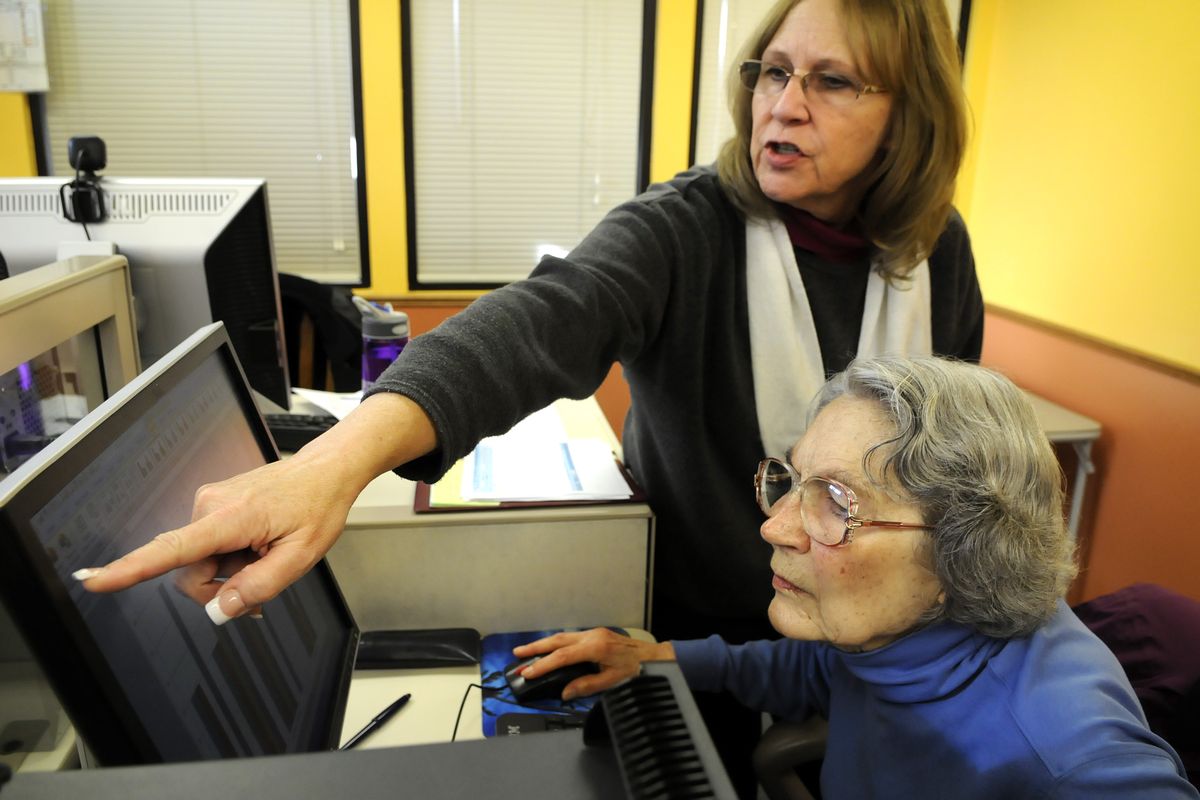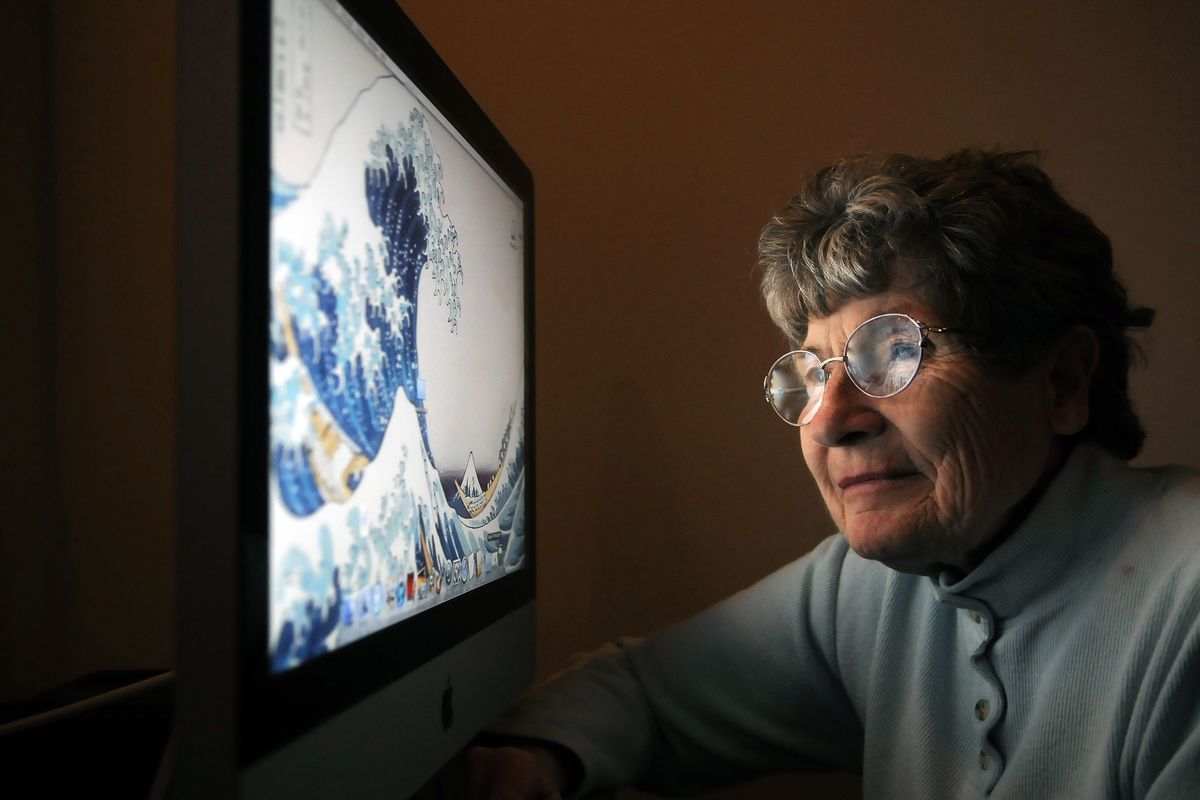Seniors work to close tech gap
Electronics companies trying to remove obstacles for older users
Florence Michaud, 77, of Spokane Valley, uses her Apple computer to exchange emails with family members or to keep up with friends. (Dan Pelle)Buy a print of this photo
Some people who’ve bought an iPad have been known to brag about their 4-year-olds figuring out how to use the digital tablet within 15 minutes.
There are many others with the opposite concern, trying to persuade an aging parent to try a new tech device so that they might start sharing photos, reading e-books or joining video chats.
Despite the increasing hype and widespread acceptance of technology, Americans over 65 are not leaping forward into the new digital age at the same rate as their younger counterparts. There’s a digital divide that’s leaving the silver-haired set on the sidelines.
A recent study from the Pew Research Center’s Internet & American Life Project found 42 percent of those over 65 go online, and only 30 percent of the 75-and-older group do.
Gary Moulton, a Microsoft project manager who focuses on how technology products are used by older adults, cites another study from Forrester Research that finds Americans over 50 show a clear drop-off in their interest in and adoption of technology. Similar studies find the same barrier in Europe, he said.
Yet tech companies see seniors as a valuable market because of their disposable income. A slightly younger demographic – so-called “golden boomers” ages 52 to 68 – make up one-fourth of the U.S. population but account for 40 percent of the dollars spent on all technology, including TVs and the like, according to the Nielsen Co.
Spokane resident Martha Draper, 84, cites a common refrain heard from technology-averse seniors: Time spent in front of a computer screen is unappealing. “I’d rather be out meeting people and talking straight to them, instead of emails,” Draper said.
Seniors who do use technology often stick to email and basic Web searches.
Many older users are put off by “apps,” cellphone screens too small to read and navigate, and the fear that data stored “in the cloud” might be misused and cost them their privacy or lead to identify theft, said Doug Shadel, executive director of Washington State AARP.
Laurie Orlov, a Florida-based writer and consultant who also writes a blog for seniors at AgeInPlaceTech.com, said seniors are “being bypassed, but we must try harder to change that.”
It goes beyond being “connected” with friends and family, she said. Studies show that as older people lose the ability to drive or get out regularly, the ability to use the Web to research hobbies or establish friendships is tied to being more active and more alert, Orlov said.
From a sociological standpoint, people who don’t connect through social media, email, video chats and smartphones risk social isolation and decreased activity as they age.
Harvard psychology professor Ellen Langer has looked at the issue and agrees.
“Older adults need to adopt technology because, to me, those in their 80s who use the Web seem more alert and engaged,” Langer said.
But, she added, “it’s not clear whether more tech use is the cause or the effect of being more active.”
Getting beyond basics
Spokane Valley resident Florence Michaud, 77, uses an Apple computer in her home for emailing with family members and to keep up on her friends. A widow with five grown children, Michaud knows how to do Google searches. Recently she heard mention on the radio about a new DVD featuring Fred Astaire.
“I went online and found it right away,” Michaud said proudly.
But she’s not likely to push beyond those limited uses. A daughter who lives in Hawaii wants her mom to use Skype, so Michaud can talk directly over the Web and see her three grandchildren in real time.
“I’ve used Skype a few times. But I don’t right now,” Michaud said. “I need to have someone show me slowly how to get it working.”
She has a cellphone but only keeps it for emergency use in her car. She has no need for a GPS system to help with directions, she said.
And Michaud avoids Facebook because “I like to talk. I’d rather just talk with people on the phone.”
While she’s ahead of the curve compared with many her age, Michaud admits she’s not adventurous and less inclined to try new technology-based services.
Orlov and other consultants advise that people wanting to get more tech-savvy can hunt for classes at the beginner’s level or above. The Southside Senior Activity Center in Spokane offers Computing 101 as well as classes in specific programs, such as Microsoft Excel.
If one-on-one training is needed, Orlov said, seniors have several options. Area stores, such as Best Buy and the Apple retail store, offer in-store classes. Their trainers typically will work on specific training as needed, she said.
Tincan, Spokane’s nonprofit training group, offers both classes and individual training.
Orlov favors one-on-one sessions, which avoid “the embarrassment and intimidation of a classroom.”
As easy as a microwave
For many companies, the goal of easier-to-use technology is clearly tied to their aging customer base.
Boomers are turning 65 at the rate of 10,000 per day in the United States. That change in demographics means that even though many of them are computer literate, their abilities will change. Vision will diminish, hand-eye coordination will deteriorate and cognitive abilities will vary as people age.
As people start reaching their 70s and 80s, they’ll expect companies to provide easier-to-use technology products, Orlov said.
Companies will have to raise their design standards, shooting for development of products that are not much more difficult to run than a microwave oven.
“People in their 70s and 80s will need tech in their lives, the same way people in their 30s and 40s today expect and need tech in their daily lives,” Orlov said.
Many vehicle manufacturers are moving in that direction, devising simpler-to-use voice-command GPS systems to help drivers. Some navigation systems already identify areas of traffic congestion, and some GPS makers are testing “healthy” navigation systems that advise a driver to avoid areas regarded as bad for anyone with asthma or bronchitis.
Car makers also are focused on the “smart car” concept, adding safety systems to alert drivers to road hazards or when they might be dozing at the wheel.
“What’s driving all those efforts, really, are carmakers looking for ways to keep their customers alive longer,” Orlov said. “They’re getting the car to think for you.”
Orlov also predicts that within a year or two every TV or home entertainment system will come with a remote with larger buttons, to help aging consumers.
Microsoft’s Moulton hears some argue the “tech divide” for those in the over-65 group today will disappear as younger generations move toward their senior years. The argument is that those folks are already comfortable technology users and will have no trouble adjusting to new things.
Moulton thinks it’s not so simple. People will not be afraid of new technology, but as they age, the technology has to be designed to be easier to use. Unlike new drugs, many tech products are not field-tested by older consumers; typically, they’re pushed out by companies run by younger people.
“Unless we make it a specific goal to not forget older users, there will always be a drop-off (in tech use) by older consumers,” Moulton said.


